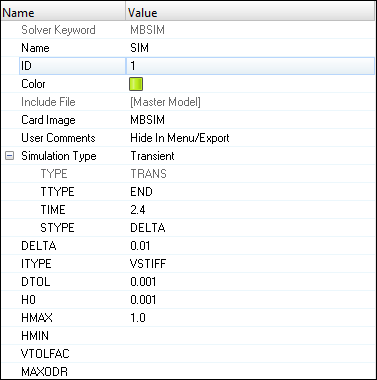OS-T: 1960 Define Point to Deformable Curve Joint
In this tutorial, a multibody dynamics analysis (simulation type: Transient Analysis) of a hook on a flexible cable are performed using OptiStruct.

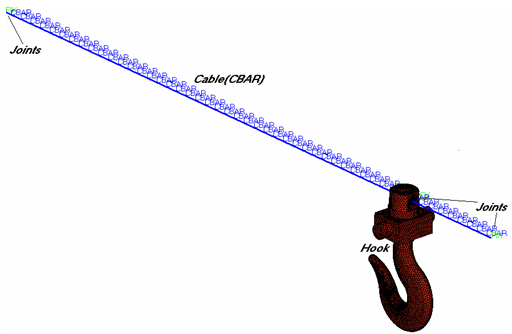
The flexible cable consists of 50 different CBAR elements (PFBODY) and the end of this flexible body is connected to ground (GROUND) using fixed joints.
The Hook (PRBODY) is an external graphic and is connected to the flexible cable by the PTDCV joint.
Launch HyperMesh and Set the OptiStruct User Profile
-
Launch HyperMesh.
The User Profile dialog opens.
-
Select OptiStruct and click
OK.
This loads the user profile. It includes the appropriate template, macro menu, and import reader, paring down the functionality of HyperMesh to what is relevant for generating models for OptiStruct.
Open the Model
- Click .
- Select the flex_cable.hm file you saved to your working directory.
-
Click Open.
The flex_cable.hm database is loaded into the current HyperMesh session, replacing any existing data.
Set Up the Model
Create Rigid Bodies (PRBODY)
- From the Analysis page, click the bodies panel.
- Select the create subpanel.
- In the body= field, enter Hook.
- Click type= and select PRBODY.
- Using the props selector, select Hook.
- Double-click nodes and select by id, then enter 14399.
- Click create.
- Click return.
Create Flex Bodies (PFBODY)
- From the Analysis page, click the bodies panel.
- Select the create subpanel.
- In the body= field, enter Cable.
- Click type= and select PFBODY.
- Using the props selector, select Cable.
- Double-click nodes and select by id, then enter 1, 2.
- Set CMS Method to Craig-Bampton.
- Verify frequency upper bound is set to upper bound default.
-
Toggle number of modes to nmodes=, and enter
15.
Figure 3. 
- Click create.
- Click return.
Create GROUND Bodies (GROUND)
- From the Analysis page, click the bodies panel.
- Select the create subpanel.
- In the body= field, enter Ground.
- Click type= and select GROUND.
- Double-click nodes and select by id, then enter 14397, 14398.
- Click create.
Define the Deformable Curve
-
In the Model Browser, right-click and select .
A default set template displays in the Entity Editor.
- For Name, enter deform_curve.
- Set Card Image to MBDCRV.
- Verify Set Type is set to ordered.
-
Select entity IDs.
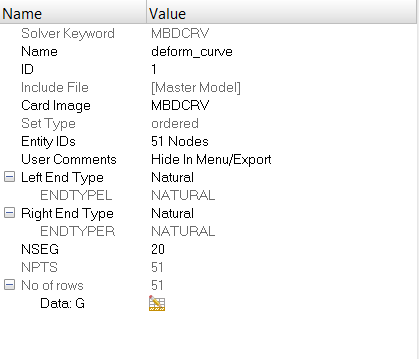
Create Joints
You will create all the necessary joints including the PTDCV joint.
-
Create the component, joints.
-
From the menu bar, click .
The Joints panel opens.
-
Create a fixed joint between one end of the Cable and Ground.
-
Create the fixed joint between the other end of the Cable and Ground.
- Set joint type to fixed.
- Select node ID 2 as the first terminal and select node ID 14398 as the second terminal.
- Click create.
-
Create the PTDCV joint.
Figure 5. 
- Click return.
Create Load Collectors
In this step you will create the gravity force that applies to the model and MBSIM Bulk Data card, which is to specify the parameter for multibody simulation.
-
In the Model Browser, right-click and select from the context menu.
A default load collector displays in the Entity Editor.
- For Name, enter gravity.
- Click Color and select a color from the color palette.
- Set Card Image to GRAV and click Close.
-
Input the values as illustrated below.
Figure 6. 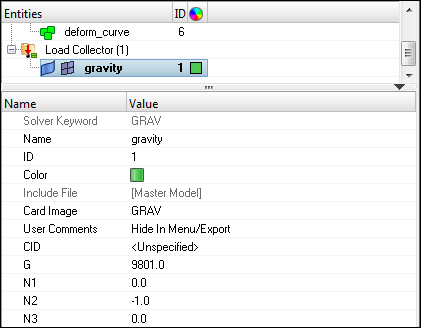
-
Create another load collector.
Create Load Steps
- In the Model Browser, right-click and select from the context menu.
- For Name, enter Dynamic.
- Set Analysis type to Multi-body dynamics.
-
Define MLOAD.
- For MLOAD, click to open Advanced Selection.
- In the dialog, select gravity and click OK.
- In Subcase Options, select .
- For MBSIM, click to open Advanced Selection.
- In the dialog, select SIM and click OK.
Submit the Job
-
From the Analysis page, click the OptiStruct
panel.
Figure 8. Accessing the OptiStruct Panel 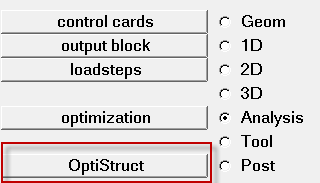
- Click save as.
-
In the Save As dialog, specify location to write the
OptiStruct model file and enter
flex_cable for filename.
For OptiStruct input decks, .fem is the recommended extension.
-
Click Save.
The input file field displays the filename and location specified in the Save As dialog.
- Set the export options toggle to all.
- Set the run options toggle to analysis.
- Set the memory options toggle to memory default.
- Click OptiStruct to launch the OptiStruct job.
- flex_cable.html
- HTML report of the analysis, providing a summary of the problem formulation and the analysis results.
- flex_cable.out
- OptiStruct output file containing specific information on the file setup, the setup of your optimization problem, estimates for the amount of RAM and disk space required for the run, information for each of the optimization iterations, and compute time information. Review this file for warnings and errors.
- flex_cable.h3d
- HyperView binary results file.
- flex_cable.res
- HyperMesh binary results file.
- flex_cable.stat
- Summary, providing CPU information for each step during analysis process.
View the Results
In this step you will view the results in HyperView, which will be launched from within the OptiStruct panel of HyperMesh.
HyperView is a complete post-processing and visualization environment for finite element analysis (FEA), multibody system simulation, video and engineering data.
-
From the OptiStruct panel of the Analysis page,
click HyperView.
The path and filename for flex_cable.h3d appears in the fields to the right of Load model and Load results. This is fine because the .h3d format contains both model and results data.
The model and results are loaded in the current HyperView window.
-
Click the Contour panel toolbar icon
 .
.
- Under Results type: select Displacement(v).
- Click Apply.
-
Start/stop the animation using the Animation Controls in the panel next to the
playback controls.
Figure 9. 
-
Verify Animate Mode is set to
 (Transient).
(Transient).
- Click the Start/Pause Animation icon to start the animation.
- With the animation running, use the bottom slider bar to adjust the speed of the animation.
- Click the Start/Pause Animation icon again to stop the animation.
-
Verify Animate Mode is set to
